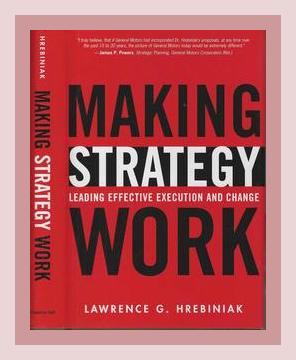Business StrategyStrategic Execution
Summary: Making Strategy Work: Leading Effective Execution and Change
I. Introduction
Lawrence G. Hrebiniak’s “Making Strategy Work: Leading Effective Execution and Change” delves deep into the realm of strategic execution—an often neglected but critical aspect of business success. Published in 2005, this book provides a wealth of practical advice and concrete examples aimed at bridging the gap between strategy development and execution. Hrebiniak stresses the importance of effective leadership, efficient processes, and organizational adjustments to ensure that strategies do not just stay on paper but are effectively realized.
II. The Challenge of Execution
Main Point: The first major point Hrebiniak addresses is the inherent challenge of executing strategy. Many organizations struggle because they underestimate the complexities involved in this process.
Actionable Step: Conduct a thorough execution audit to identify potential barriers to strategy implementation within your organization.
Example: Hrebiniak cites the case of a multinational corporation where a meticulously planned strategy fell apart because regional managers were not aligned with the central vision due to poor communication channels.
III. Importance of a Robust Organizational Structure
Main Point: Hrebiniak stresses that a strong, well-defined organizational structure is essential for effective strategy execution. Without it, roles become ambiguous, leading to confusion and inefficiencies.
Actionable Step: Clarify roles and responsibilities within the organization. Ensure that every employee understands their part in the overall strategy.
Example: He discusses a technology company that successfully implemented its new product strategy by redesigning its organizational structure to create cross-functional teams, thereby enhancing collaboration and accountability.
IV. The Role of Leadership in Strategy Execution
Main Point: Leadership plays a pivotal role in making strategy work. Effective leaders are not only visionaries but also strong executors.
Actionable Step: Leaders should engage in active communication and regularly check in with their teams to ensure progress aligns with strategic goals.
Example: Hrebiniak references a retail chain where the CEO held weekly meetings with store managers to review performance metrics and discuss obstacles, thereby fostering a culture of accountability and continuous improvement.
V. Creating a Culture of Execution
Main Point: For a strategy to be successfully executed, it must be ingrained into the organizational culture. Employees should be motivated and aligned with the strategy’s objectives.
Actionable Step: Develop incentive programs that reward employees for behaviors and performance that support strategic objectives.
Example: He speaks of a pharmaceutical company that introduced a bonus system tied to the achievement of strategic goals, which significantly improved employee engagement and execution effectiveness.
VI. Aligning Strategy with External Environment
Main Point: Strategies should be adaptable and responsive to changes in the external environment. Static strategies are likely to fail in dynamic markets.
Actionable Step: Establish a monitoring system to continuously assess external factors such as market trends, competitor actions, and regulatory changes.
Example: Hrebiniak highlights a manufacturing firm that swiftly adapted its supply chain strategy in response to new trade tariffs, allowing it to maintain competitive advantage.
VII. Effective Communication Channels
Main Point: Effective communication is crucial in strategy execution. Clear, consistent, and coherent communication can drive alignment and focus.
Actionable Step: Develop a comprehensive communication strategy that includes regular updates, feedback mechanisms, and transparent information sharing.
Example: The book mentions an insurance company that used an internal newsletter and town hall meetings to keep everyone informed and engaged with the strategic direction, leading to improved coordination and execution.
VIII. Incentives and Rewards Systems
Main Point: Properly aligned incentives and rewards systems are essential for motivating employees to work towards strategic objectives.
Actionable Step: Design and implement a rewards system that ties compensation to strategic performance metrics.
Example: Hrebiniak provides an example of a consulting firm that tied bonuses to client satisfaction scores, which were directly linked to the firm’s strategy of prioritizing client service quality.
IX. Managing Change and Overcoming Resistance
Main Point: Change management is a critical component of strategic execution. Resistance to change can derail even the best-laid plans.
Actionable Step: Implement change management practices, including stakeholder analyses, change ambassadors, and continuous education programs to ease transitions.
Example: He describes a financial services company that experienced resistance to a new IT system. By proactively involving employees in the planning and training phases, the company was able to smooth the transition.
X. Measuring and Monitoring Performance
Main Point: Ongoing performance measurement and monitoring are indispensable for successful strategy execution. It’s essential to set clear metrics and regularly review performance.
Actionable Step: Use balanced scorecards or other performance management tools to track progress and make necessary adjustments in real-time.
Example: Hrebiniak adds the case of a telecom firm using balanced scorecards to align divisional activities with overall strategic objectives, thus ensuring cohesive execution across the organization.
XI. Integrating Strategy and Operations
Main Point: Strategy should not be seen as separate from day-to-day operations. The two must be seamlessly integrated for effective execution.
Actionable Step: Ensure that operational plans are directly linked to strategic objectives. Use techniques like cascading goals to align operations with strategy.
Example: He talks about a global beverage company that linked its production schedules and supply chain logistics to strategic market expansion plans, thereby ensuring alignment and coherence in execution.
Conclusion
Hrebiniak’s “Making Strategy Work: Leading Effective Execution and Change” provides a comprehensive guide for businesses aiming to close the gap between strategy formulation and its actualization. Through a host of actionable steps and rich examples, the book emphasizes the crucial roles of leadership, structure, culture, communication, incentives, change management, performance measurement, and operational alignment in achieving strategic success. By following the principles outlined in this book, organizations can significantly improve their strategic execution capabilities and drive sustainable growth.
